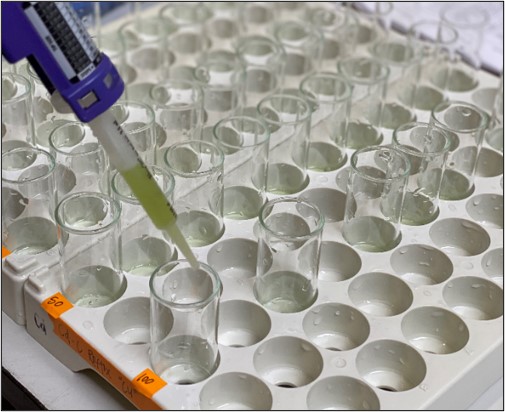Study probing variability in Ceriodaphnia toxicity testing results enters final phase

An ongoing, SCCWRP-facilitated study probing why California laboratories have been unable to produce consistent results with a toxicity test commonly used to evaluate discharge water quality has ruled out an initial set of possible causes and has begun pursuing more nuanced potential explanations.
The study’s initial findings – reviewed in December by the project’s five-member science advisory committee and 10-member stakeholder advisory committee – indicate that there is no “smoking gun” explanation for the variability in results for the Ceriodaphnia dubia chronic reproduction test, a test method that utilizes the Ceriodaphnia dubia water flea and has been used since the mid-1980s. While some California laboratories during the study demonstrated consistent results, other laboratories’ results were variable from test to test.
The approved method for conducting the Ceriodaphnia test gives laboratories some flexibility in adapting exactly how they perform the test, including limited options for what to feed the test organism, the laboratory reagents used to create dilution water, and age of the organisms used to initiate the test.
Project stakeholders in January recommended that researchers focus the study’s final phase on education and training in an effort to constrain the number of variations in laboratory techniques. Participating laboratories will implement the streamlined method options during a second and final round of split-sample testing to see if variability in results can be reduced.
Environmental managers have used the Ceriodaphnia test for decades as part of a suite of toxicity tests to protect California’s enclosed bays, estuaries and inland water bodies from contaminated discharges. But in recent years, end users of the Ceriodaphnia test have expressed growing concerns about accuracy, repeatability and consistency associated with interpreting test results.
These concerns came into sharp focus in 2020, as the California State Water Resources Control Board was preparing to adopt numeric water-quality objectives for a full suite of aquatic toxicity tests – a policy change known as the Toxicity Provisions.
In response to end-user concerns about the Ceriodaphnia test, the State Water Board postponed implementing numeric objectives for the Ceriodaphnia test until early 2024. The numeric objectives for other toxicity test species were adopted in late 2020.
The Ceriodaphnia test is a foundational toxicity test for evaluating water quality for wastewater and stormwater discharges. Unlike some toxicity testing that focuses on whether the test organism lives or dies, the Ceriodaphnia reproduction test focuses on whether the fleas are able to reproduce – typically a more sensitive endpoint.
In 2020, both the regulated and regulatory communities asked SCCWRP to lead an investigation into the source(s) of variability in the test results.
Researchers initiated the study by compiling data from about 1,000 toxicity tests spanning the past three years and representing all 18 laboratories that are accredited to perform the test in California. More than 1,000 person-hours was spent compiling the data; however, the data analysis did not point to one lab technique as the source of variability in test results.
Project participants then completed an initial round of split-sample intercalibration testing last summer and last fall to generate new data for analysis.
What became clear from the split-sample testing is that no two laboratories in California are conducting the test exactly the same way. Moreover, the number and variety of method options in use are confounding researchers’ ability to pinpoint which laboratory technique (or techniques) is the source of variability in the results.
Thus far, the most promising – albeit far from conclusive – lead appears to be variations in the age of the female Ceriodaphnia used to initiate brood boards for the test. During the first round of split-sample testing, this organism ranged in age from 6 to 14 days old. Researchers will investigate this potential source of variability during the second and final round of split-sample testing.
The project is scheduled to be completed by this summer with development of best-practices guidance to minimize variability of results; the guidance will be published in time to guide laboratories in implementing the State Water Board’s new toxicity provisions for the Ceriodaphnia reproduction toxicity test.
To receive periodic updates on the ongoing study, sign up for the State Water Board’s toxicity listserv.
For more information, contact Ken Schiff and Dr. Alvina Mehinto.
More news related to: Runoff Water Quality, Top News